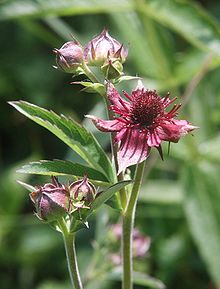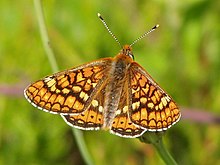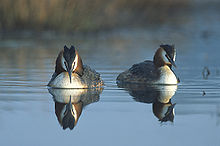Kreuzweiher-Langensee
|
"Kreuzweiher-Langensee" nature reserve |
||
|
NSG Kreuzweiher-Langensee |
||
| location | Neukirch in the Lake Constance district , Baden-Württemberg , Germany | |
| surface | 74.09 ha | |
| Identifier | 4,070 | |
| WDPA ID | 164258 | |
| Geographical location | 47 ° 39 ' N , 9 ° 41' E | |
|
|
||
| Setup date | December 21, 1973 October 20, 1994 (expansion) |
|
| administration | Regional Council Tübingen | |
The Kreuzweiher-Langensee area is a designated nature reserve (NSG number 4070) in the area of the Baden-Württemberg community of Neukirch in Germany, which was designated by ordinance of December 21, 1973 of the Tübingen regional council and expanded on October 20, 1994 .
location
The approximately 75 hectare Kreuzweiher-Langensee nature reserve , in the southwest of Neukirch, between the districts of Wildpoltsweiler , Unterlangensee , Oberlangensee and Wittenberg , at an altitude of around 440 m above sea level. NN located, is one of the natural area for Westallgäuer hills .
Protection purpose
The main protection purpose of the NSG Kreuzweiher-Langensee is the preservation of a richly structured ecosystem . It consists of the two ponds Cross Pond and Lake Maggiore , whose water Flora, silting belt near the shore, low-nutrient flat and slope fen areas , moor grass - wet meadows , orchards , Erlenbruchwald areas and grassland areas as buffer zones further to avoid intensification of agricultural land in the surrounding area of the wetlands serve.
Hydrology
Langensee
The inlet of the 5.6 hectare Langensee takes place via meadow ditches, the catchment area covers about 67 hectares. The mean depth of the lake is 1.1 meters, the maximum depth 1.4 meters, its volume around 59,000 cubic meters . The Langensee drains into the Kreuzweiher.
Kreuzweiher
The Kreuzweiher has a catchment area of around 450 hectares. The main inflow is the straightened Wiesengraben, into which the inflows from the direction of Hüttensee, Neukirch and Bernried flow from the Langensee. It has a water surface of 5.7 hectares. Its average depth is 1.3 meters, the maximum depth 2.0 meters; this results in a volume of 74,400 cubic meters. The process takes place via Kreuzweiherbach and Bollenbach into the Argen .
Flora and fauna
flora

( Potentilla palustris )

( Iris sibirica )
The following plant species (selection) are to be named from the flora worthy of protection or observed :
- Bear moss family : Swamp moss or moor moss ( Lycopodiella inundata )
- Valerian plants : Small valerian ( Valeriana dioica ) or swamp valerian
- Gentianaceae : Spring gentian ( Gentiana verna ), gentian ( Gentiana pneumonanthe ), Willow Gentian ( Gentiana asclepiadea )
- Fever clover family : Fever clover or bitter clover ( Menyanthes trifoliata )
- Frog-bite family : Great mermaid ( Najas marina )
- Buttercup family : tongue buttercup ( Ranunculus lingua ) or large buttercup
- Heather family : common cranberry ( Vaccinium oxycoccos ), rosemary heather ( Andromeda polifolia )
- Heart leaf family : Swamp heart leaf ( Parnassia palustris )
- Aster family : common water deast or Kunigunden herb ( Eupatorium cannabinum )
- Mint : Ufer-Wolfstrapp ( Lycopus europaeus )
- Myrsine family : common loosestrife ( Lysimachia vulgaris ) or common loosestrife
- Pink family : Superb Pink ( Dianthus superbus )
- Orchids : Broad-leaved orchid ( Dactylorhiza majalis ), flesh-colored orchid ( Dactylorhiza incarnata ), marsh orchid ( Liparis loeselii ), marsh stendellus ( Epipactis palustris )
- Primrose family : flour primrose ( Primula farinosa ) or floury cowslip , ostrich loosestrife ( Lysimachia thyrsiflora )
- Red family : bog bedstraw ( Galium uliginosum )
- Rose plants : Meadowsweet ( Filipendula ulmaria ), swamp blood-eye ( Potentilla palustris )
- Cyperaceae : trichophorum alpinum ( Trichophorum alpinum ) Broad cotton grass ( Eriophorum latifolium ), sludge-sedge ( Carex limosa ), Schmalblättriges cotton grass ( Eriophorum angustifolium ), White beak-sedge ( Rhynchospora alba ), dioecious sedge ( Carex dioica )
- Iris family : Siberian iris ( Iris sibirica ) - also meadow iris
- Water lily plants : White water lily ( Nymphaea alba )
- Sundew Family : Drosera anglica ( Drosera anglica also -) long leaf sundew or English sundew , Sundew ( Drosera rotundifolia ) - also heavenly dew or God spoon or Widdertod called
- Spindle trees : swamp heart leaf ( Parnassia palustris )
- Water hose family : common butterwort ( Pinguicula vulgaris ), common water hose ( Utricularia vulgaris ), small water hose ( Utricularia minor ), middle water hose ( Utricularia intermedia )
fauna
The following animal species (selection) are to be named from the fauna worthy of protection or observed :
fishes
- Perch : Zander ( Sander lucioperca ) - also sander or pike perch
- Real catfish : Catfish ( Silurus glanis ) - regionally also catfish
- River eels : European eel ( Anguilla anguilla )
- Pike : pike ( Esox lucius )
- Carp fish : bream ( Abramis brama ), silver bream ( Blicca bjoerkna ) - also looks or half bream , carp ( Cyprinus carpio ), roach ( Rutilus rutilus ) - also roach or Schwal , Rudd ( Scardinius erythrophthalmus ) or red chalk , tench ( Tinca tinca )
insects

( Euphydryas aurinia )
- Butterflies
- Large Heath ( Coenonympha tullia ), also known as Big Heufalter or moor Heath referred
- Phengaris Alcon ( Phengaris alcon ), including Little Moorbläuling called
- Meadowsweet mother-of-pearl butterfly or violet silver butterfly ( Brenthis ino )
- Scabiosen-Scheckenfalter ( Euphydryas aurinia ), also Goldener Scheckenfalter or Abiss-Scheckenfalter
Birds

( Podiceps cristatus )
- Bunting : Reed Bunting ( Emberiza schoeniclus ) - also Rohrspatz called
- Kingfishers : Kingfisher (Alcedo atthis)
- Duck birds : Mute swan ( Cygnus olor ), teal duck ( Anas querquedula ), pochard ( Netta rufina ), teal ( Anas crecca ), pochard ( Aythya ferina )
- Pheasants : Quail ( Coturnix coturnix )
- Flycatcher : Whinchat ( Saxicola rubetra )
- Warbler : Great Reed Warbler ( Acrocephalus arundinaceus ), Reed Warbler ( Acrocephalus scirpaceus ) - Bird of the Year 1989
- Hawk species : Black kite or black kite ( Milvus migrans ), Montagu's harrier ( Circus pygargus )
- Grebes : Great crested grebe ( Podiceps cristatus ) - bird of the year 2001, black-necked grebe ( Podiceps nigricollis ), little grebe ( Tachybaptus ruficollis ) - the smallest European representative of the grebes
- Gulls : Black-headed gull ( Larus ridibundus )
- Barrel birds : pond rail ( Gallinula chloropus ) - often also called moorhen , spotted moorhen ( Porzana porzana ), water rail ( Rallus aquaticus )
- Herons : Gray Heron ( Ardea cinerea ), Bittern ( Botaurus stellaris ), Little Bittern ( Ixobrychus minutus )
- Snipe birds : common snipe ( Gallinago gallinago ), curlew ( Numenius arquata ), woodcock ( Scolopax rusticola )
trail
Around the nature reserve leads from Wildpoltsweiler (here parking and bathing in the Kreuzweiher) over Unterlangensee, Oberlangensee and Summerau back to Wildpoltsweiler an approximately seven kilometer long circular path with easy to moderately difficult inclines. Part of this path runs parallel to the first stage of the Jubiläumsweg Bodenseekreis , a 111-kilometer hiking trail that was signposted in 1998 to mark the 25th anniversary of the Bodenseekreis. It leads over six stages through the hinterland of Lake Constance from Kressbronn via Neukirch, Meckenbeuren , Markdorf , Heiligenberg and Owingen to Überlingen .
Sporting opportunities
At the outflow of the Kreuzweiher, near Wildpoltsweiler, there is a bathing facility with a jetty and sunbathing area.
See also
literature
- Department for nature conservation and landscape management: nature reserves in the administrative district of Tübingen . Ed .: Regional Council Tübingen. Second revised and expanded edition. Thorbecke, Ostfildern 2006, ISBN 978-3-7995-5175-5 , pp. 282-284 .
Web links
- Action program for the rehabilitation of Upper Swabian lakes
- Weblink of the State Institute for the Environment, Measurements and Nature Conservation Baden-Württemberg (LUBW)
Individual evidence
- ↑ partly mentioned by S. Gors: The vegetation of the LSG Kreuzweiher in the Württemberg Allgäu . Landesstelle Naturschutz Landschaftspflege Baden-Württemberg, Vol. 37, 1969, pp. 7–61.




